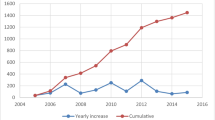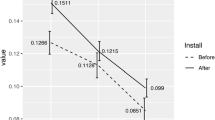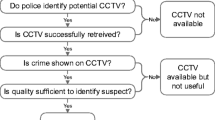Abstract
A non-monitored closed-circuit television (CCTV) pilot project commenced at the Scott Road Skytrain Station Park and Ride in Surrey, BC in August 2009. The pilot project was implemented by the City of Surrey and scheduled for 1 year. This article reports on an evaluation of the CCTV system with respect to its ability to reduce vehicle-related crime at the pilot site. Using police and insurance data, the evaluation considers the trends of vehicle-related crimes over several years in the City of Surrey and the northern district of the Corporation of Delta, BC. In general, there is little evidence of a significant drop in vehicle-related crime that can be attributed to the CCTV system. Moreover, we show that the results are dependent on the methods used for evaluation; this is critical because we show that a more commonly used method (that we consider inappropriate) indicates a significant drop in vehicle-related crime.


Similar content being viewed by others
Notes
We would like to thank Paul J. Brantingham for this insight.
References
Barclay, P., Buckley, J., Brantingham, P.J., Brantingham, P.L. and Whin-Yates, T. (1997) Preventing auto theft in commuter lots: A bike patrol in Vancouver. In: R.V. Clarke (ed.) Situational Crime Prevention: Successful Case Studies, 2nd edn. Guilderland, NY: Harrow and Heston, pp. 143–156.
BCStats. (2010) Population estimates – Municipalities, regional districts and development regions: 2006 to 2009 [data file], http://www.bcstats.gov.bc.ca/DATA/pop/pop/estspop.asp#totpop, accessed 22 February 2010.
Boggs, S.L. (1965) Urban crime patterns. American Sociological Review 30 (6): 899–908.
Brantingham, P.J. and Brantingham, P.L. (2003) Anticipating the displacement of crime using the principles of environmental criminology. Crime Prevention Studies 16: 119–148.
Brantingham, P.L. and Brantingham, P.J. (1995) The criminality of place: Crime generators and crime attractors. European Journal on Criminal Policy and Research 3 (3): 5–26.
Castle, A. (2008) Criminal theory lesson #1: Fear, victimization, and the real rates of crime. Why is public perception so different from reported crime rates? (Interview between Allan Castle and Belle Puri aired on Monday, 18 February 2007). CBC special series: Neighbourhood 911 http://www.cbc.ca/bc/features/neighbourhood911/programming.html, accessed 28 March 2007.
City of Surrey. (2007) City of Surrey Crime Reduction Strategy, http://www.surrey.ca/Inside+City+Hall/Your+Mayor+and+Council/Crime+Reduction+Strategy/default.htm, accessed 28 March 2007.
City of Surrey. (n.d.) History of Surrey, http://www.surrey.ca/6555.aspx, accessed 22 February 2010.
Cornish, D.B. and Clarke, R.V. (eds.) (1986) The Reasoning Criminal: Rational Choice Perspectives on Offending. New York: Springer-Verlag.
Cornish, D.B. and Clarke, R.V.G. (1987) Understanding crime displacement: An application of rational choice theory. Criminology 25 (4): 933–947.
CTV News Staff. (2002) Surrey named car theft capital of North America, http://www.ctv.ca/CTVNews/Canada/20020907/bc_car_theft_020907/, accessed 16 March 2012.
Eck, J.E. (2005) Evaluation for lesson learning. In: N. Tilley (ed.) Handbook of Crime Prevention and Community Safety. Portland, OR: Willan Publishing, pp. 699–733.
Fotheringham, A.S. and Wong, D.W. (1991) The modifiable areal unit problem in multivariate statistical analysis. Environment and Planning A 23 (7): 1025–1044.
Gehlke, C.E. and Biehl, K. (1934) Certain effects of grouping upon the size of the correlation coefficient in census tract material. Journal of the American Statistical Association Supplement 29 (185): 169–170.
Gill, M., Little, R., Spriggs, A., Allen, J., Argomaniz, J. and Waples, S. (2005) Assessing the Impact of CCTV: The Hawkeye Case Study (Home Office Online Report 12/05). London: Home Office.
Gill, M. and Spriggs, A. (2005) Assessing the Impact of CCTV (Home Office Research Study No. 292). London: Home Office.
Harries, K.D., Stadler, S.J. and Zdorkowski, R.T. (1984) Seasonality and assault: Explorations in inter-neighborhood variation, Dallas 1980. Annals of the Association of American Geographers 74 (4): 590–604.
Kerr, C. and Bottril, D. (2009) Corporate report to mayor and council: Closed circuit television pilot project – Scott Road Skytrain car park, http://www.surrey.ca/bylawsandcouncillibrary/R177-510B.pdf, accessed 10 April 2012.
Magnan, B. (2008) Statistics disguise true crime levels. The Vancouver Sun, 30 January, http://www.canada.com/vancouversun/news/editorial/story.html?id=1aed0a18-df48-4bcb-a5ca-d2706e1bbf16, accessed 28 March 2010.
Maltz, M. (1977) Crime statistics: A historical perspective. Crime and Delinquency 23 (1): 32–40.
Openshaw, S. (1984) The Modifiable Areal Unit Problem, CATMOG (Concepts and Techniques in Modern Geography) 38. Norwich, UK: Geo Books.
Piehl, A.M., Cooper, S.J., Braga, A.A. and Kennedy, D.M. (2003) Testing for structural breaks in the evaluation of programs. Review of Economics and Statistics 85 (3): 550–558.
Pittman, D.J. and Handy, W.F. (1962) Uniform crime reporting: Suggested improvements. Sociology and Social Research 46 (2): 135–143.
Police Services. (n.d.) British Columbia policing jurisdiction crime trends 1998–2008, http://www.pssg.gov.bc.ca/police_services/publications/statistics/Jurisdictional_Crime_Trends_1999-2008.pdf, accessed 24 March 2010.
Poyner, B. (1997) Situational crime prevention in two parking facilities. In: R.V. Clarke (ed.) Situational Crime Prevention: Successful Case Studies, 2nd edn. Guilderland, NY: Harrow and Heston, pp. 157–166.
Ratcliffe, J.H. (2001) On the accuracy of TIGER-type geocoded address data in relation to cadastral and census areal units. International Journal of Geographical Information Science 15 (5): 473–485.
Ratcliffe, J.H. (2004) Geocoding crime and a first estimate of a minimum acceptable hit rate. International Journal of Geographical Information Science 18 (1): 61–72.
Sellin, T. (1931) The basis of a crime index. Journal of Criminal Law and Criminology 22 (3): 335–356.
Sellin, T. (1957) Crime in the United States. Life Magazine, 43, 09 September.
Sherman, L.W., Gartin, P.R. and Buerger, M.E. (1989) Hot spots of predatory crime: Routine activities and the criminology of place. Criminology 27 (1): 27–56.
Skogan, W.G. (1975) Measurement problems in official and survey crime rates. Journal of Criminal Justice 3 (1): 17–32.
Skogan, W.G. (1977) Dimensions of the dark figure of unreported crime. Crime and Delinquency 23 (1): 41–50.
Statistics Canada. (2006) Criminal Victimization in Canada, 2004. Ottawa, ON: Canadian Centre for Justice Statistics.
Tibbits, C. (1932) Crime. American Journal of Sociology 37 (6): 963–969.
Tilley, N. (1993) Understanding Car Parks, Crime and CCTV: Evaluation Lessons from Safer Cities, Crime Prevention Unit Series Paper No. 42. London: Home Office.
Weisburd, D., Wyckoff, L., Ready, J., Eck, J., Hinkle, J.C. and Gajewski, F. (2006) Does crime just move around the corner? A controlled study of spatial displacement and diffusion of crime control benefits. Criminology 44 (3): 549–591.
Welsh, B.C. and Farrington, D.P. (2009) Public area CCTV and crime prevention: An updated systematic review and meta-analysis. Justice Quarterly 26 (4): 716–745.
Zyartuk, T. (1994) Scott Road worst for crime. The Surrey Now 12 October: p.1.
Acknowledgements
We would like to thank Paul J. Brantingham, Greg Jenion, Colleen Kerr, Lance Talbott, Sgt Tom Thompson and Katie Wuschke for their help and comments on earlier drafts of this article. We would also like to thank the Royal Canadian Mounted Police, the Insurance Corporation of British Columbia and the Transit Police for the provision of data. Lastly, we wish to acknowledge Bonnie Fisher and two anonymous reviewers whose comments have significantly improved the quality of this article.
Author information
Authors and Affiliations
Corresponding author
Appendix
Appendix
Rights and permissions
About this article
Cite this article
Reid, A., Andresen, M. An evaluation of CCTV in a car park using police and insurance data. Secur J 27, 55–79 (2014). https://doi.org/10.1057/sj.2012.14
Published:
Issue Date:
DOI: https://doi.org/10.1057/sj.2012.14




